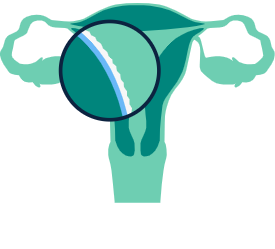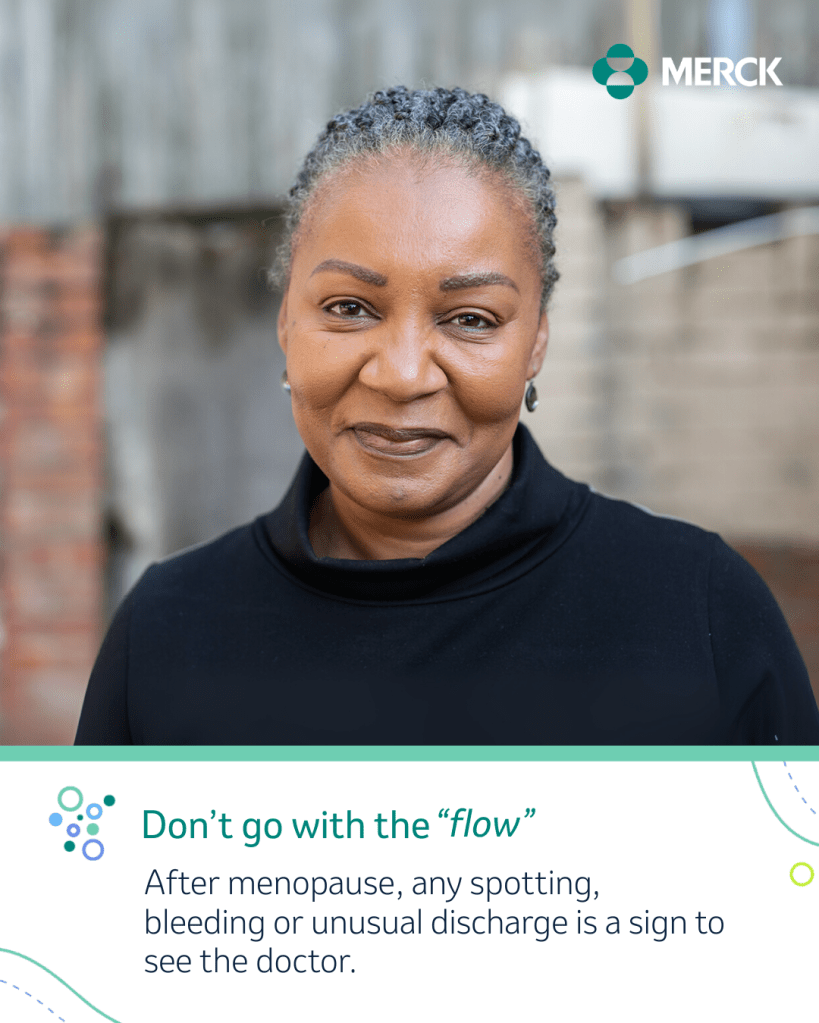

Vaginal spotting, bleeding or unusual discharge after menopause are the most common signs of endometrial cancer. Don’t ignore them. Talk to your doctor.
Endometrial cancer is the most common gynecologic cancer in the U.S., and it continues to be on the rise. However, many are not aware of the early warning signs: ANY spotting, bleeding or unusual discharge after menopause.

Approximately 9 in 10 postmenopausal adults
with endometrial cancer had spotting or
bleeding as an early sign of cancer.*
*Based on an analysis of 129 studies spanning 1977-2017

The transition into menopause usually starts between ages 45 and 55 and can last a few years. You’ve finished menopause when you haven’t had a period or spotting for a full year.
After menopause, any spotting, bleeding or unusual discharge is a sign to see the doctor.

Endometrial cancer starts in the lining inside your uterus. This lining is called the endometrium.
About 90% of uterine cancers are endometrial cancers. Because of this, people often use “endometrial cancer” and “uterine cancer” to mean the same thing.

There is no regular screening for endometrial cancer.
It’s important to see your doctor as soon as you notice any early signs or symptoms, before the cancer has a chance to grow or spread.
If endometrial cancer isn't caught early, it can show up in other ways:

Pelvic discomfort

Pain when peeing

Pain during sex

Losing weight without trying
If you notice any of these changes, it’s a good idea to talk to your doctor.
What are my chances of getting endometrial cancer?
The chances of getting endometrial cancer increase as you get older, especially after menopause. We must normalize talking about the signs and potential risk factors and having these conversations with a doctor.

Risk factors for endometrial cancer
Age
The risk goes up as you get older — most cases occur in adults over 45 and those who have gone through menopause. If you’ve already gone through menopause and see any signs of spotting or bleeding, or unusual discharge, you should always talk to your doctor.
Obesity
Fat tissue makes extra estrogen, which raises your risk. A high-fat diet and lack of exercise can contribute to obesity and fat tissue.
Estrogen-only hormone replacement therapy
In adults who have a uterus, receiving estrogen alone can increase the risk of endometrial cancer.
Certain life events may increase estrogen exposure
Increased exposure to estrogen increases your risk of endometrial cancer. Your exposure to estrogen is higher if you started periods at an early age, have never been pregnant or went through menopause at a later age.
Health conditions
Diabetes, high blood pressure, previous radiation therapy in the pelvic area (for a different cancer) or polycystic ovary syndrome (PCOS) may increase your risk.
Family history
If you or members of your family had cancer at a younger age, ask your doctor about Lynch syndrome and Cowden syndrome. These are inherited conditions that can cause certain cancers before age 50, including endometrial cancer.

Notice changes to your body as they happen.

Learn about your risk factors for endometrial cancer.

Visit your doctor for regular gynecologic care even after menopause.
Any spotting, bleeding or unusual discharge after menopause should prompt doctors to check for — or rule out — endometrial cancer using the following tests:

A scan that takes pictures of the inside of your uterus to check for a tumor and to see if the lining is thicker than it should be. The scan can be done over the belly (pelvic ultrasound) or inside the vagina (transvaginal ultrasound).

The most used test for endometrial cancer and very accurate for those who have gone through menopause. It uses a thin tube that is inserted through the vagina to suction off a small bit of tissue from inside your uterus. The tissue is then looked at under a microscope to see if there is anything unusual.

A thin tube with a tiny camera is inserted through the cervix (the canal that connects the vagina to the uterus) to check for a tumor in the uterus.

The cervix is gently opened so tissue can be collected from the inner lining of the uterus.
Your health matters
It’s important to be informed about your unique risk factors and talk with your doctor to make the choices that are right for you.

Endometrial cancer is one of the few cancers in the U.S. where the number of people affected continues to grow every year. This might be partly caused by the rise in risk factors for endometrial cancer, including higher rates of obesity and diabetes and lower birth rates. Talk with your doctor about your risk for endometrial cancer, so you can take action for your health.
Share the facts
Share the facts about endometrial cancer with your friends, family and loved ones. Say it in your own way, and be loud.






